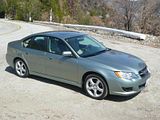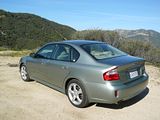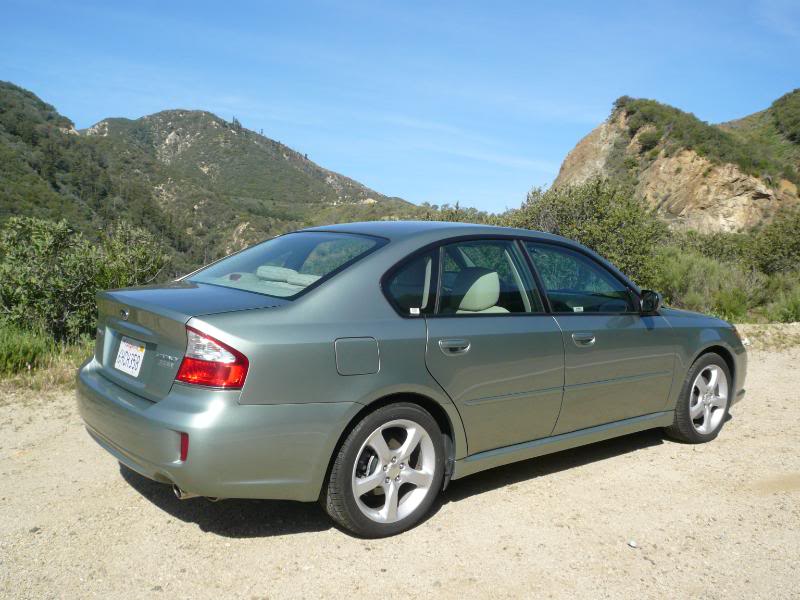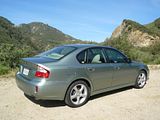
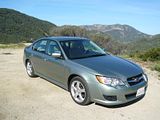
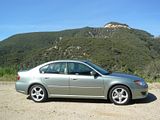
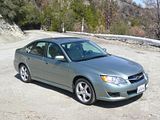
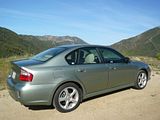

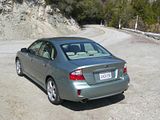
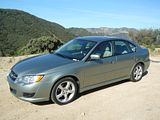
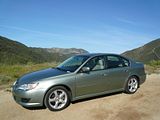
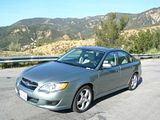
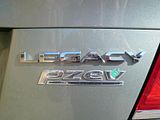
 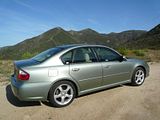
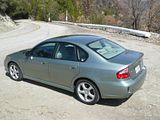
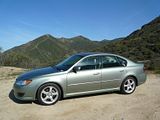
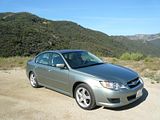
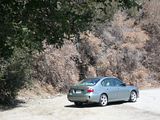
|
When it became clear that I was not readily going to be able to squeeze my suitcase into the boot of the allotted convertible which was waiting for me at LAX for the final leg of this trip, I wandered around the Hertz facility to see what I could find as a possible substitute, and my attention focused on the sole example of the now obsolete Subaru Legacy, in sedan trim. I had driven a couple of different versions of this car in the past – an Outback when the model first came out, which I had picked up from this same spot in late 2004, and a 3.0 Estate car which I hired in Zurich and drove to Munich, and for which a report is already posted to this website. The saloon is a much rarer beast, even in the US, so I figured I would go and ask for this car, as a final reminder of when Subaru made cars (at least for now) that have not been designed with the Ugly Stick. I was also intrigued by the badging on the back, which proclaimed the car to be a Partially Zero Emissions Vehicle.
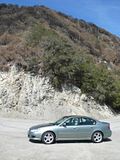 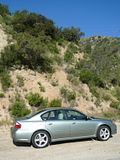 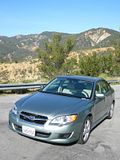 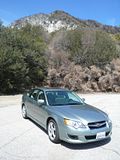 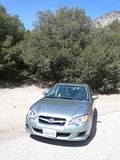 
I have to confess that I was intrigued by PZEV, so I looked it up. To my mind, Zero is Zero, so I wondered how it could be Partially Zero. Subaru’s explanation is as follows: the catalytic converter features a finer honeycomb mesh to more effectively convert exhaust gases by neutralising them through a chemical reaction. A charcoal filter in line with the engine air filter absorbs fuel and oil vapours that normally escape into the atmosphere when a typical engine is turned off. Special fuel injectors also reduce evaporative emissions when the car is at rest. The ignition timing is automatically adjusted on start-up to heat the catalytic converter more quickly and ensure that the emissions controls are working at peak efficiency at all times. The explanation that I sourced on the web goes onto to say that this can mean a rather unusual noise when you start the Legacy PZEV up. Well, with a flat four Subaru, unusual noise is what you expect, and probably rather revel in. The first time I fired it, I did get a bit of a surprise, but after that, the traditional Subaru boxer-engined noise seemed rather too muted to be particularly distinctive. The net of this is that the PZEV is apparently the cleanest running petrol engine car in the USA, with zero evaporative emissions and meeting California’s SULEV (Super Ultra Low Vehicle Emissions) standard, making it 90% cleaner from an emissions point of view than other cars. It is an interesting idea that what matters is the complete emissions not just the CO2 which has become the sole focus of manufacturers who sell in the EU markets. There is no difference in power output compared to the non-PZEV cars, and Subaru claim that maintenance costs are no higher. Clever.
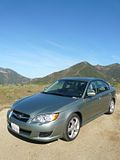 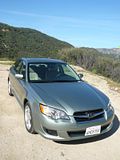 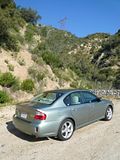  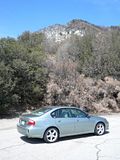
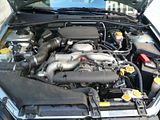 In America, the Legacy sedan is positioned as a mid-sized sedan, competing with the likes of Carmy, Accord, Fusion, Altima, Malibu and Sonata, all of which outsell it by some margin. That probably does not trouble Subaru unduly, as although sales volume is important, they remain a niche player, and pride themselves in offering something that bit different. What is special about the car in this class is that it comes with all wheel drive, which, as a standard feature, is a unique. The test car came fitted with the 2.5 litre four cylinder boxer engine, and in this form, it develops 170 bhp. That puts it on a par with the power output of the Kia Optima I had sampled only a couple of days previously, and bang on target for the class. It is sufficient, but no more. The engine is willing, but once you rev it beyond about 3000 rpm, which you probably will do, it gets quite noisy. It is not a particularly unpleasant noise, but it is less peaceful than say the Kia proved to be. Going up the slopes of the canyons around the Los Angeles area, I found that the engine was having to work quite hard, doubtless due to the weight of the Legacy – that four wheel drive technology does not weigh nothing. Standard transmission is a five speed manual, but the test car came with the optional four speed automatic. It has a psuedo manual mode on it, but i found if best to leave the selector in “D”. The weight of the Legacy and the mountain routing doubtless took its toll on the fuel economy, too, as I averaged around 24 mpg US, which is less than I have seen in other cars in its class. On the plus side, I did enjoy the handling, which was better than that of the Kia, and it meant that the car was quite fun to take around the swooping bendy roads up in the mountains. The steering is light, but with sufficient feel. The brakes are good, and as this is only an American car by manufacture (it is assembled in Indiana), it has a pull up handbrake between the seats rather than a foot operated pedal to get in the way of your left foot. In America, the Legacy sedan is positioned as a mid-sized sedan, competing with the likes of Carmy, Accord, Fusion, Altima, Malibu and Sonata, all of which outsell it by some margin. That probably does not trouble Subaru unduly, as although sales volume is important, they remain a niche player, and pride themselves in offering something that bit different. What is special about the car in this class is that it comes with all wheel drive, which, as a standard feature, is a unique. The test car came fitted with the 2.5 litre four cylinder boxer engine, and in this form, it develops 170 bhp. That puts it on a par with the power output of the Kia Optima I had sampled only a couple of days previously, and bang on target for the class. It is sufficient, but no more. The engine is willing, but once you rev it beyond about 3000 rpm, which you probably will do, it gets quite noisy. It is not a particularly unpleasant noise, but it is less peaceful than say the Kia proved to be. Going up the slopes of the canyons around the Los Angeles area, I found that the engine was having to work quite hard, doubtless due to the weight of the Legacy – that four wheel drive technology does not weigh nothing. Standard transmission is a five speed manual, but the test car came with the optional four speed automatic. It has a psuedo manual mode on it, but i found if best to leave the selector in “D”. The weight of the Legacy and the mountain routing doubtless took its toll on the fuel economy, too, as I averaged around 24 mpg US, which is less than I have seen in other cars in its class. On the plus side, I did enjoy the handling, which was better than that of the Kia, and it meant that the car was quite fun to take around the swooping bendy roads up in the mountains. The steering is light, but with sufficient feel. The brakes are good, and as this is only an American car by manufacture (it is assembled in Indiana), it has a pull up handbrake between the seats rather than a foot operated pedal to get in the way of your left foot.
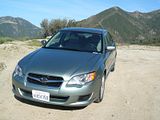 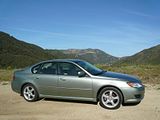
Just like the Kia, the test Legacy was beige inside. However, rather less of the interior was beige than in the Optima. The dash is a mostly black, as are the floor carpets, which is doubtless more practical once dirty feet get in and out. The overall quality of the interior design is high, and the Legacy proves that Subaru can do what they so singularly failed to manage with the Impreza, which is to design an attractive interior and then make it out of good quality materials. The graphics on the main dials are perhaps smaller than in most cars, but still proved easy to read. The centre of the dash contains a lidded storage area, which is an alternative to the screen for satellite navigation. At the bottom of this area, angled somewhat are digital displays for the clock and outside temperature. These proved hard to read, especially in bright sunlight. Under this is the single slot CD stereo system, and then the air conditioning controls. It is all very neat, and the materials used are generally of good quality. The seats, power adjustable for the driver, and which proved very comfortable have a velour inset to them, which I rather liked.
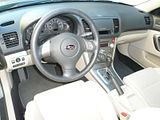 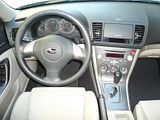 
As the Legacy is positioned as a family car, room for people and luggage clearly counts. No issues with leg room for the rear seat passengers, but headroom could be a bit tight. My head did not quite touch the roof/rear window, but it was awfully close. In fact in the front, with the seat set as low as it would go, the driving position felt high and there was not much clearance for my head there, either. Three adults could sit in the back of the Legacy without undue compromise or feeling squeezed in, but I suspect that two would feel more comfortable. The boot, which appeared to have no external release at all, just a lever by the driver’s seat and the button on the key fob, is commodious, and it can be extended by folding down the lockable rear seat back rests. Doing so gives a flat and long load space. Inside the cabin, there is a small centre cubby, situated well, back, two cup holders under a roller cover, a glove box with a shelf in it, door bins and there is a cubby hole high up in the middle of the dash on this model, as there is no screen for the absent sat nav system.
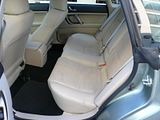 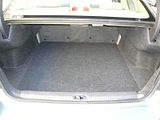
Although in Europe we only see a limited range of different models, in the US, Subaru offer more choice. In addition to the regular and PZEV equipped 2.5i engines, there is a GT spec version of the 2.5, which with its turbocharged powerplant puts out 243 bhp. There are also 3.0R models, which come with Subaru’s wonderful H6 engine, which I so enjoyed in the Legacy Estate I sampled. The base models can be upgraded through the SE and Limited trims, before hitting the GT and GT Spec B. The 6 cylinder cars come as R and R Limited. In entry level trim, you get air conditioning, but not climate control, and (nice) cloth seats. My test car was a Special Edition, which adds an electric sunroof, and unlike the estate, this is a one-piece item, which slides back inside the car. There was no buffeting when it was open, and I enjoyed toasting the top of my head on what turned out to be an increasingly cloudy day. You also get a Harman Kardon sound system, which worked well, and an eight power adjustable driver’s seat. The Limited trim brings climate control and leather seats, as well as a stereo upgrade, front fog lights and a leather wrapped steering wheel. Upgrade to the GT and you are mostly getting the more powerful engine, but that also brings sports suspension and lower profile 17″ tyres. The Spec B brings 18″ wheels and some more luxury items such as a memory setting for the driver’s seat, along with leather/alcantara upholstery and satellite navigation.
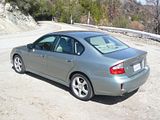 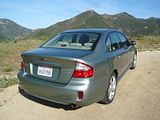 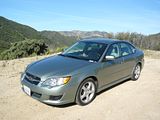
At just under $23,000 for this version of the Legacy, it is a little more costly than many of its four cylinder rivals. Is it worth the premium? “Maybe”, would have to be my conclusion. In purely objective terms, only the handling was demonstrable superior to the Kia. But there is still that question of brand and reputation. Which would you rather have? A Kia, with all its (perhaps outdated) connotations? or a Subaru? Of course, if I was picking a Subaru, I would want to stretch the budget to a more powerful model. I’ve driven the 3.0 model, in Estate and Outback form, and thought it terrific. I think I have to conclude that if the budget would stretch that far, the Subaru would be a very compelling proposition, but in non turbo 2.5i cooking form, where the requirement is simply for basic family transport, the Subaru is not the class leader. That said, if you picked one, I don’t think you’d be disappointed with your choice.
|
